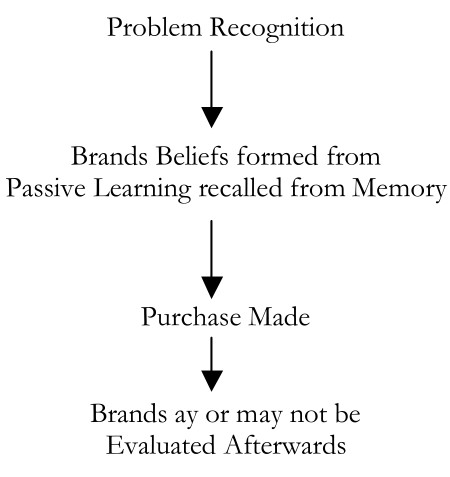This type of brand buying behavior is seen when there is a high level of consumer involvement with the purchase, but the consumer perceives only minor differences between competing brands. Such consumers may be confused by the lack of clear brand differences. They would not have any firm beliefs about the advantages of any particular brand, a choice will most probably be made based on other reasons such as, for example, a friend’s opinion or advice given by a shop assistant.
After he has purchased, he may feel unsure, particularly if he receives information that seems to conflict with his reasons for buying. He would experience mental discomfort, or what we call as ‘post-purchase dissonance’ and would attempt to reduce this state of mental uncertainty. He would either try to ignore the dissonant information or will seek those messages, which confirm his prior beliefs.
In this type of brand decision, the consumer makes a choice without firm brand beliefs, and then changes his attitude after that purchase-often on the basis of experience with the chosen brand. Finally, learning occurs on a selective basis to support the original brand choice by the consumer being attentive to positive information and ignoring negative information.
Limited Problem Solving
This kind of decision making happens when we do not regard the buying of certain products as important issues, and when we perceive only minor differences between competing brands in these product fields, egg, pens, packaged groceries, etc. in such circumstances the buying behavior can be called as limited problem solving process.

Problem recognition will be straightforward issue. For example, an item in the household may be running low will beep. So we would not be particularly interested in seeking information from different sources. We might have received the message passively through television commercial. Alternative evaluation, if any takes place after the purchase. In effect, fully formed beliefs, attitudes and intentions are the outcomes of purchase and not the cause. We are likely to regard the cost of information search and evaluation as outweighing the benefits.
In these cases we passively receive information and process it in such a way that it is stored in our memories without making much of an impact on our existing mental structure. No behavioral change occurs until we come across a purchase trigger at a point at which we need to purchase the product in question. Once we have bought it and are satisfied with it, we are likely to form a kind of a belief to be used for repeat brand buying.
When we regularly purchase these kinds of brands, we establish buying strategies that reduce the effort in decision making like routine problem solving. Hence, in low involvement buying the ‘right brand’ is less central to our lifestyle and brand switching becomes more easily achieved through coupons, free trial incentives. We generally show variety seeking behavior as we feel little risk in switching between brands. And also overtime, we get bored buying the same brand and occasionally seek variety by switching

